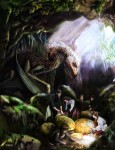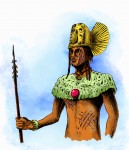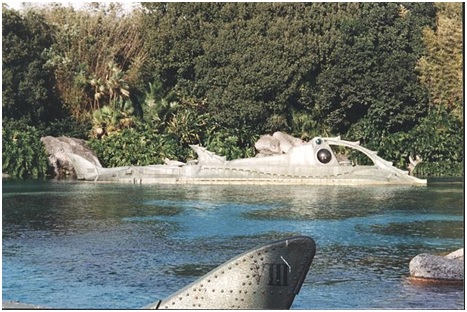The making of Pirates & Dragons, the RPG
By Ken Walton & Peter Cakebread
Back the Kickstarter here.
In The Beginning
We’ve always liked pirates. And dragons. When the idea popped into our heads to make a role-playing game called Pirates & Dragons, we were amazed no-one had beaten us to it. After all, since both are very fond of gold, the conflict inherent in the situation is obvious, and conflict is at the heart of RPGs.
The idea of a group of islands, each with a dragon’s mountain lair, came early. But where should we set it? Most of our previous game settings (Clockwork & Chivalry, Clockwork & Cthulhu and Dark Streets) have been strongly historically-based, even though we’ve added elements of the fantastical. Should we do the same again? But we had a flintlock-and-steel style fantasy background called Realms of Gold on the backburner. It wasn’t long before the two projects sort of merged and became much more focussed – on the pirates, and the dragons.
Where Be Dragons?
 We had toyed with the idea of adding dragons to the Caribbean, but we quickly realised that turning the Caribbean into a larger fantasy world would give us more freedom to develop the game in strange and interesting ways, while keeping the tropes that people would instantly recognise. We drew a sketch map, using the Caribbean as a starting-point, but expanding off in all directions. What started as a hand-drawn sketch on Ken’s tablet was turned into a beautiful poster map by our art director, Gary Buckland. By developing the cultures of the major islands, but leaving many of the smaller islands undocumented, we were creating a sandbox into which Games Masters could drop their own adventure locations, while still providing plenty of fleshed out areas for the GM in a hurry.
We had toyed with the idea of adding dragons to the Caribbean, but we quickly realised that turning the Caribbean into a larger fantasy world would give us more freedom to develop the game in strange and interesting ways, while keeping the tropes that people would instantly recognise. We drew a sketch map, using the Caribbean as a starting-point, but expanding off in all directions. What started as a hand-drawn sketch on Ken’s tablet was turned into a beautiful poster map by our art director, Gary Buckland. By developing the cultures of the major islands, but leaving many of the smaller islands undocumented, we were creating a sandbox into which Games Masters could drop their own adventure locations, while still providing plenty of fleshed out areas for the GM in a hurry.
Who’s Who?
It was obvious from the start that the Adventurers were going to be the pirates, and the dragons were going to be the bad guys. We wanted big, powerful ancient dragons, full of malice, sitting on piles of treasure. But we didn’t want all dragons to be so formidable, or the Adventurers would never take them on. So we decided that the young dragons would be smaller and less powerful – a threat to a pirate ship, but not an overwhelming threat. As they grow older, they grow more powerful, but also more indolent – why leave your treasure hoard, when you can bully the local islanders into feeding you and increasing your riches? And, since zombies have become something of a staple in pirate movies (I blame Tim Powers’ novel On Stranger Tides), we decided to give the dragons zombie servants, drawn from the native islanders who worship the great beasts.
 Now what about the Islanders themselves? We didn’t particularly want to reproduce the horrors of the African slave trade in our game, and knowledge of the original inhabitants of the Caribbean is sketchy at best, so we decided to create our own native culture – the Islanders, a stone-age people who gain magic from the spirits of the islands because of the respect they have for the natural world. These contrast with the Dragon Tribes, who use the power of the dragon they worship to force the island spirits to do their will.
Now what about the Islanders themselves? We didn’t particularly want to reproduce the horrors of the African slave trade in our game, and knowledge of the original inhabitants of the Caribbean is sketchy at best, so we decided to create our own native culture – the Islanders, a stone-age people who gain magic from the spirits of the islands because of the respect they have for the natural world. These contrast with the Dragon Tribes, who use the power of the dragon they worship to force the island spirits to do their will.
Of course, pirates need enemies and victims – the forces of law and order in the form of colonial navies, and merchant shipping to raid. We came up with four colonial powers, the Uropans, instantly recognisable, but not limited by any one period in history. The Esbanians are inspired by the Conquistadors, shipping vast quantities of gold from the New World, and trying to convert the native islanders to the True Faith. The Albionics come from an island nation and hunt young dragons for natural resources, in the same way that whales were hunted in the real world. The Batavians have developed technology (particularly weapons) beyond that available to any other nation. And the Gaules have just had a revolution in which their king was deposed to make way for a republic.
 As the world began to take shape, it grew richer. Having watched lots of pirate movies in our quest for inspiration, we began to think of other favourite movies which might feed into the mix. After seeing a few old Ray Harryhausen films, we started to think that such tropes could well form a part of the backdrop. The Storm Circle developed – an area of sea buffeted in the centre by a perpetual swirling storm. But what was in the centre of that storm? Maybe the ancient island city of Adalantas, centre of a once great advanced civilisation that lost an epic war with the dragons before the dawn of history. Their ruins lie scattered about the Dragon Isles, still guarded by giant mythological creatures and animated statues of ancient gods, and inhabited by the Low Adalantans, degenerate blue humanoid cannibals.
As the world began to take shape, it grew richer. Having watched lots of pirate movies in our quest for inspiration, we began to think of other favourite movies which might feed into the mix. After seeing a few old Ray Harryhausen films, we started to think that such tropes could well form a part of the backdrop. The Storm Circle developed – an area of sea buffeted in the centre by a perpetual swirling storm. But what was in the centre of that storm? Maybe the ancient island city of Adalantas, centre of a once great advanced civilisation that lost an epic war with the dragons before the dawn of history. Their ruins lie scattered about the Dragon Isles, still guarded by giant mythological creatures and animated statues of ancient gods, and inhabited by the Low Adalantans, degenerate blue humanoid cannibals.
The Insect People came as a bit of a surprise. Starting off as a short entry in the bestiary, they quickly took on a life of their own – a hive-dwelling species who produce firesilk, a flame-proof material used for ships’ sails in the dangerous dragon-haunted waters of the Dragon Isles. Their civilisation is largely unknown and misunderstood by the Uropans, and the Esbanians have gone so far as to declare that they are demons that must be wiped out – much to the annoyance of the other colonial powers, who are happy to trade with them.
The Rules
As the world developed, so did the rules. We’d already decided to use our own D100 rules system, Renaissance which is built on Newt Newport’s OpenQuest, itself a variant of RuneQuest. But the Renaissance rules were designed for the grim and gritty world of Clockwork & Chivalry; we needed something that was recognisably compatible, but emulated the unlikely stunts and derring-do of Hollywood pirate movies. We tweaked the combat rules, adding a new skill, Swashbuckling, that allows you to perform stunts in combat, as well as making things less realistic but more fun. (For instance, if you disarm someone, their weapon is likely to fly up into the air and can be caught by someone nearby as it comes down). We beefed up hero points and turned them into Doubloons – a pool of tokens that players can draw from to give themselves critical successes, max damage, rerolls, the finding of improvised weapons and the like. You gain another Doubloon every time you roll a successful double, but beware – if the Doubloon you’re spending turns out to have the Black Spot on its underside, things can go horribly wrong!
We simplified the magic system to make it very fast to play – all Islanders have a few spells, and shamans have a lot more, but only the (NPC) Dragon Tribes have access to necromancy. We added stackable Traits which can be bought with Improvement Points to give your character special abilities. And, of course, we added very simple ship-to-ship, crew-to-crew and ship-to-dragon combat rules, which keep the emphasis on role-playing rather than turning the RPG into a war-game.
The Future
We have some great plans for future supplements once the rulebook is out – a Bestiary of creatures from the islands (there are plenty to get you going in the core rulebook, but there’s always room for more). Gazeteers of the islands with more details about the main cultures, cities and settlements; adventure modules detailing individual islands and the ruins and dragon lairs to be explored on them; a players’ guide to the cultures with extra character professions. As time goes on, we’ll develop further aspects of the world, delving into the underground hive cities of the Insect People, and withdrawing the veil over the Storm Circle to reveal the secrets of the High Adalantans. There’s a lot to explore in the Dragon Isles!
The Kickstarter
Of course, to get all this off the ground, we need your support: we’ve currently got a Kickstarter running at http://www.kickstarter.com/projects/1317990451/pirates-and-dragons-the-rpg – pledge if you can, and please, tell all your friends!
